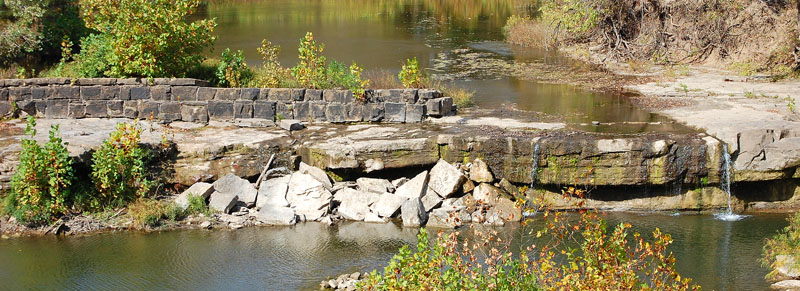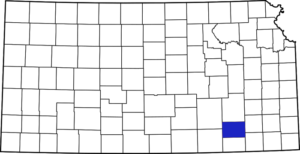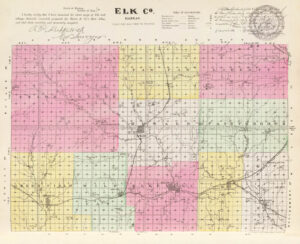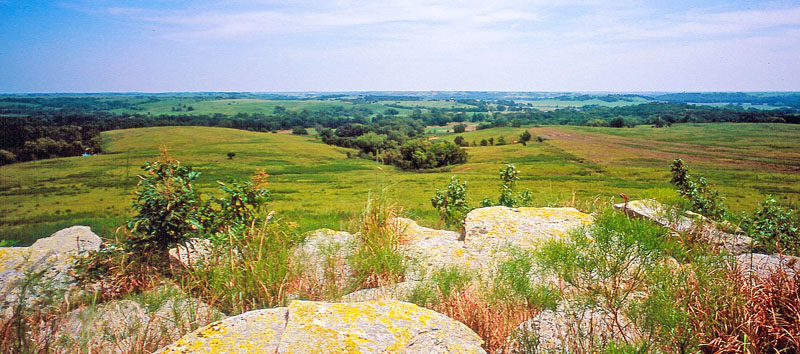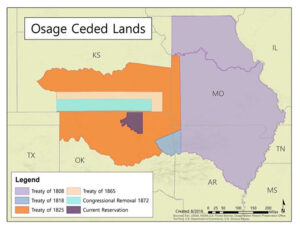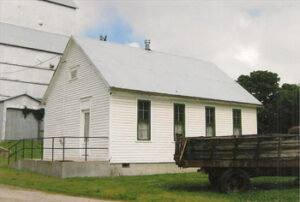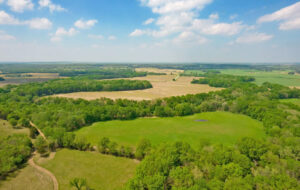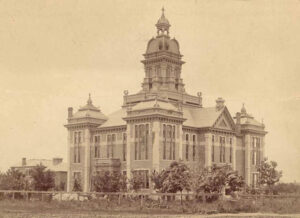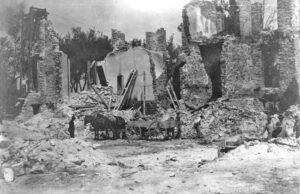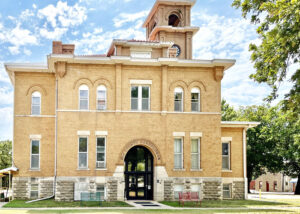Towns & Places:
Elk Falls
Grenola
Howard – County Seat
Longton
Moline
One-Room, Country, & Historic Schools of Elk County
Elk County, Kansas, in the southeastern part of the state, was named for the Elk River, a tributary of the Verdigris River. The county seat and most populous city is Howard. As of the 2020 census, the county population was 2,483.
It is the fourth county west of the Missouri line and in the second tier north of Oklahoma. It is bounded on the north by Greenwood County, on the east by Wilson and Montgomery, on the south by Chautauqua, and on the west by Cowley and Butler Counties.
It is located in the Osage Cuesta region with rolling hills and Chautauqua Hills with sandstone outcroppings. The surface is rolling, and in some places, hilly and bluffy. Bottomlands, which averaged about one mile in width, comprised 20% of the area. The timber belts along the streams averaged a quarter of a mile in width and consisted of oak, cottonwood, elm, hackberry, box elder, maple, hickory, butternut, red-bud, and sycamore. The principal stream is the Elk River, which enters the county in the northwest corner and flows southeast. Its main tributaries are Wild Cat, Paw Paw, and Painterhood Creeks. There are numerous other streams. Well water was found at a depth of 20 feet. Sandstone and limestone were abundant, marble of fair quality and coal were found in limited amounts, and oil and gas were present in commercial quantities.
In 1854, after first serving as an area to relocate Native American tribes from the east, the United States organized the Kansas Territory. The area that today is Elk County was, for a brief period, reserved for the Osage Indians as hunting grounds for buffalo and other game.
In 1855, Godfrey County, which comprised present-day Chautauqua and Elk Counties, was established. It was named in memory of Bill Godfrey, a trader among the Osage Indians. Godfrey County was not surveyed and had no white settlers except the few trappers and traders bartering with the Indians for pelts and beaded goods.
In common with the surrounding territory, the lands of Elk County were settled before they were legally open to white occupation. Richard Graves was the first white man to locate within the county’s limits in 1856. The Indians twice drove him out, and he finally abandoned his claim. A strip of land six miles wide along the eastern border, which was legally open to settlement, was the attraction that drew the earliest immigrants. However, once here, many more adventurous people risked their lives to take up the rich lands in the river bottoms that belonged to the Indians.
In 1861, Kansas was admitted as the 34th state of the United States. That year, Godfrey County’s name was changed to Seward County.
In the Reconstruction days after the Civil War, the name of Seward County was again changed to Howard County in honor of Major General O.O. Howard, a soldier of the Union Army in the Civil War.
The Missionary Baptists in Liberty Township established the first church organization in 1866.
The land at this time belonged to the Osage Indians, upon which legal settlement could not be made. There was, however, a strip of land extending along the northern part of the county, six miles wide, known as the “ceded strip,” upon which legal settlement could be made. Consequently, it was along the streams included within this belt where the earliest settlements were made. But it was not long before it was confined to this narrow limit. Bold, adventurous men there were, who became attracted by the beautiful and fertile valleys of the Elk River and its tributary streams, and at the risk of their lives among the Indians, upon whose rights they were intruding, and with expectations of being driven off by United States troops, they determined to make an effort to settle upon these desirable lands. Only a few at first attempted, and, in consequence, their presence was not distasteful to the authorities or alarming to the Indians.
Howard County was made up of lands acquired from the Great and Little Osage Indians by the United States Government by a treaty in the fall of 1867. At that time, Seward County’s name was changed to Howard County in honor of Oliver O. Howard, a Union General during the Civil War. Elk Falls was selected as a county seat.
More settlers continued to come in until, in 1870, the number of “squatters” had become quite considerable. Among those leaders of the vanguard who came to stay were J.C. Pinney, James Shipley, R.M. Humphrey, Elison Neat, H.G. Miller, J.B. Roberts, and others.
Among those who settled within the legal limits were Isaac Howe and Eliza Lewis, among the first five in Liberty Township. The claims were all staked out by private surveys, which caused a great deal of trouble among claimants when the government conducted its survey. Those who had been possessors of fine tracts of land by private survey often found themselves without anything or only with a small strip when actual lines were run. The land cut off by the government survey had no legal owner, but parties were ready to file on it without delay. This led to claim wars, which sometimes resulted in the death of one of the parties involved and sometimes were settled peacefully. The Osage finally agreed to cede their lands in a 1870 treaty and move to Indian Territory, now Oklahoma.
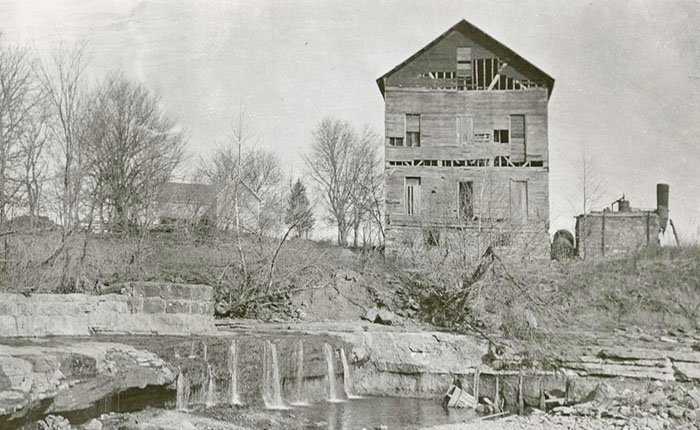
Mill and waterfalls in Elk Falls, Kansas.
An election was held in 1870 at the request of a petition, and voters chose to move the county seat to Peru. However, people were still unhappy and demanded another election. By that time, the population of Howard County was 2,794
The dissension among the towns of Elk Falls, Howard, Boston, Peru, and Longdon, which had reached a serious and lawless stage and involved three militia companies, led to the organization of Elk County in 1871. That year, the first church building was erected in Longton, and the first newspaper published was the Howard County Ledger by Adrian Reynolds.
The 1872 county seat election was declared fraudulent. The 1873 election allowed voters to decide between Elk Falls and Boston. When Elk Falls won, the people of Boston waged war. About 150 armed men entered Elk Falls and loaded county records in their wagons. The militia organized to recover the missing documents. When that failed, the district court ordered the arrest of those responsible. The records were surrendered in exchange for the release of prisoners who were returned to Elk Falls.
Though steps were taken to have two new counties formed to address concerns about size, county seats, and politics, this was not accomplished until 1875, when Edward Jaquins introduced a bill in the legislature that was passed, and Howard County was divided into two parts: the north half was called Elk County, and the south half was called Chautauqua County.
Elk County was organized by calling an election at which the following officers were chosen: Commissioners Thomas Wright, John Hughes, and G. W. McKey; County Clerk Thomas Hawkins; County Treasurer W.W. Jones; Sheriff J. W. Riley; Register of Deeds Frank Osborne; probate judge, A.P. Searcy; county attorney, S. B. Oberlander; county superintendent, J.N. Young. The county has suffered twice from defaulting treasurers and once from a defaulting sheriff.
The county was divided into ten townships: Elk Falls, Greenfield, Howard, Liberty, Longton, Oak Valley, Painterhood, Paw Paw, Union Center, and Wild Cat.
In the spring of 1871, Adrian Reynolds brought the first printing press to Howard County and began publishing the Howard County Ledger. In the summer of the same year, C.L. Goodrich established the Elk Falls Examiner and continued its publication for about one year.
In the spring of 1872, the Messenger entered Howard under the management of Turner & Kelley. It lived about a year and a half when it was sold to A. B. Hicks and taken to Boston, where It became the Howard County Messenger and Weekly News, edited by C.H. Lewis of Cedar Vale. R.S. Turner edited and published The Divisionist during the 1871 campaign. Joseph Mount began publishing the Record at Peru in the spring of 1872, where he continued until the summer of 1874, and then moved to Sedan, where he published the Wide Awake, Illustrated. The “illustrations were said to have killed the editor.” In the summer of 1873, Ward & Pyle began publishing the Elk Falls Journal, whose days were numbered, for about six months, until they sold it to Turner & Kelley, who ran it until July 1875. Then, they went to Sedan and merged it with the Chautauqua Journal.
By October 1872, the county had 118 organized school districts, 113 schools, and 1,069 pupils enrolled.
In the fall of 1874, A.B. Steinbarger brought his paper, called the Courant, from Elk City to Longton, where he stayed for about a year. He again migrated, taking up quarters at Howard, and put forth the Beacon, still retaining his paper at Longton, but soon brought that to Howard. In 1877, the Courant merged with the Elk County Ledger, edited by A. Reynolds, and became known as the Courant-Ledger. In 1879, the name was changed to Courant, and in October 1881, it was sold to the Courant Company, which was owned by Asa Thompson and Sons.
In 1876, after Elk County was created, it had a population of 7,082.
Railroad building in the latter 1870s was important. The Southern Kansas Railroad, which was to be routed from Kansas City via Independence to Wellington, was planned to be built through the county. Also, the St. Louis and San Francisco Railroad negotiated for a right of way across the county for an extension from Joplin, Missouri, to Wichita. These roads were typically surveyed through Howard, and the counties were asked to vote on bonds as a bonus to the railway company to help defray preliminary expenses. Many meetings were held to discuss the pros and cons, and heated debates occurred. One delegate declared his township was absolutely against bonds, as some of his neighbors had left the east to get away from the clutches of the “cussed” railroads.
Consequently, the Frisco passed just over the line in Greenwood County, and the townships in the southern part of the county voted in favor of the bonds. The Southern Kansas Railroad entered the county east of Oak Valley, passing through five towns, and then left the county west of Grenola. In 1879, the Atchison, Topeka & Santa Fe Railroad built an extension from Emporia to Howard.
In 1879, the citizens of Howard erected a courthouse in return for the county seat being located there. The agricultural society of Elk County was organized that year and held yearly fairs. A large fairground was provided by the county adjoining the city of Howard and was suitably furnished with buildings as required, as the expenditure of means would permit. That year, Elk County had 74 organized school districts with an enrollment of 2,181, requiring the employment of 88 teachers.
The total acreage of Elk County was 416,640. Of this, 46,318 acres were in cultivation in 1876, and 68,942 in 1882. The total value of all the property in the county in 1876 was $1,051,054, while in 1882 it was $1,368,978. In 1876, the county had 2,832 horses, 354 mules, 9,885 cattle, 4,382 sheep, and 2,092 hogs. In 1882, the numbers were: Horses, 4,034; mules, 563; cattle, 21,352; sheep, 26,264; hogs, 11,929. During those years, little manufacturing was carried out in the county, and it was mostly confined to mills for flour production. Of these, there are seven in the county, located as follows: Longton, Oak Valley, Grenola, Union Center, Western Park, Elk Falls, and Moline.
In 1882, the county superintendent’s report showed that there were 4,150 school-age children in the county. Of these, 2,025 were males, and 2,125 were females. There were 75 schoolhouses in the county, and four districts had no schoolhouses. There were three graded schools in the county — Longton, Grenola, and Howard. At that time, the population of Elk County was over 12,000.
When the Atchison, Topeka, and Santa Fe Railroad took control of the Southern Kansas Railroad in 1886, an extension was built to Moline, giving Howard a much better rail outlet. A third line ran southeast from Longton into Montgomery County, connecting cattle ranches and farms to eastern markets.
Elk County’s population peaked at 12,216 in 1890. The population fell almost every decade in the next century, especially after the 1940s.
The first Elk County Courthouse in Howard burned on October 24, 1906. The following year, a new courthouse was built at 127 N. Pine in Howard from 1907 to 1908. Architect George E. McDonald designed the yellow-buff colored brick building, which features elements of the Richardsonian Romanesque and Italian Renaissance Revival styles. Topeka’s Morse Contracting built it. It is approximately 89 feet by 74 feet in plan and is two stories high, set on a raised basement, with the bottom level finished in rusticated limestone. It was listed on the National Register of Historic Places in 2009.
The towns and villages in 1910 were Blanche, Busby, Cave Springs, Chaplin, Elk Falls, Grenola, Howard, the county seat, Longton, Moline, Oak Valley, Upola, and Western Park.
At that time, the farm products of the county amounted to about $2,250,000 a year. The total area was over 400,000 acres, with nearly two-thirds of it under cultivation. In 1876, 46,000 were cultivated, and by 1882, the number had increased to 68,000. The number of apple trees in 1882 was 58,000, as against 100,000 in 1910. The most valuable crop was Indian corn, which brought in $250,000 a year. Kafir corn came next and was worth about $150,000 annually. Other leading products were millet, oats, wheat, hay, livestock, poultry, butter, and eggs. The total assessed valuation of the property was over $14,000,000, as opposed to $1,000,000 in 1880. The population in 1910, according to the government census report, was 10,128, about ten times what it was in 1880.
Farming and ranching remain important industries in the county, and the region is also home to a significant wind energy project.
Elk County properties listed in the National Register of Historic Places include the Romanesque- and Italian Renaissance-style Elk County courthouse, built in 1907, the wrought iron Elk Falls Pratt Truss Bridge, constructed in 1892, and the Grenola Mill and Elevator on Railroad Avenue in Grenola, the Howard National Bank in Howard.
©Kathy Alexander/Legends of Kansas, updated April 2025.
Also See:
Sources:
Blackmar, Frank W.; Kansas: A Cyclopedia of State History, Vol I; Standard Publishing Company, Chicago, IL 1912.
Cutler, William G.; History of Kansas; A. T. Andreas, Chicago, IL, 1883.
Elk County Facebook
Kansapedia
Wikipedia

